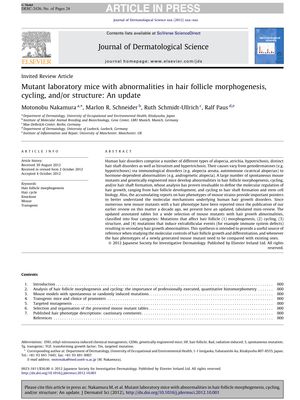Mutant laboratory mice with abnormalities in hair follicle morphogenesis, cycling, and/or structure: An update
January 2013
in “Journal of Dermatological Science”

TLDR The document concludes that mouse models are crucial for studying hair biology and that all mutant mice may have hair growth abnormalities that require detailed analysis to identify.
The document is an updated review from 11 years ago that categorizes mutant laboratory mice with hair growth abnormalities into four groups based on the type of abnormality: morphogenesis, cycling, structure, and extrafollicular events causing secondary abnormalities. It highlights the necessity of quantitative histomorphometry for analyzing hair follicle development and cycling, and discusses common errors in hair phenotype analysis. The review emphasizes the value of mouse models, including those with spontaneous or induced mutations and transgenic mice, for understanding hair biology and pathology. It also provides tables summarizing gene alterations in various mouse mutants and the associated hair abnormalities, noting that changes in hair follicle dynamics may not always be visible and that all mutants should be considered to have a hair phenotype until proven otherwise through detailed analysis.
View this study on jdsjournal.com →
Cited in this study

research The Hair Follicle as a Dynamic Miniorgan
Hair follicles are complex, dynamic mini-organs that help us understand cell growth, death, migration, and differentiation, as well as tissue regeneration and tumor biology.
research Hair follicle-specific keratins and their diseases
Only a few hair-specific keratins are linked to inherited hair disorders.
research Analysis of Hair Follicles in Mutant Laboratory Mice
research Mutant laboratory mice with abnormalities in hair follicle morphogenesis, cycling, and/or structure: annotated tables
Mutant mice help researchers understand hair growth and related genetic factors.

research The Biology of Hair Follicles
Hair follicle biology advancements may lead to better hair growth disorder treatments.
Related

research Mutant laboratory mice with abnormalities in hair follicle morphogenesis, cycling, and/or structure: An update
The document concludes that mouse models are crucial for studying hair biology and that all mutant mice may have hair growth abnormalities that require detailed analysis to identify.

research Disorders of hair growth : diagnosis and treatment
Many hair loss conditions can be treated.